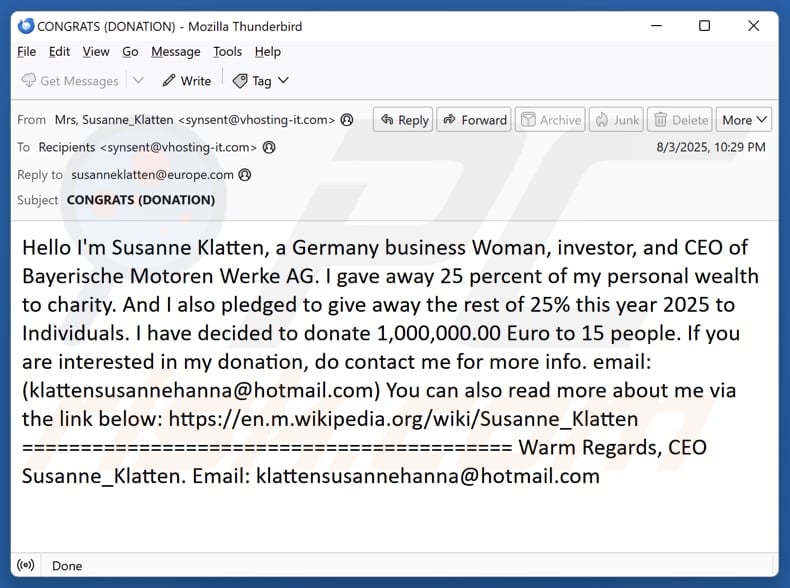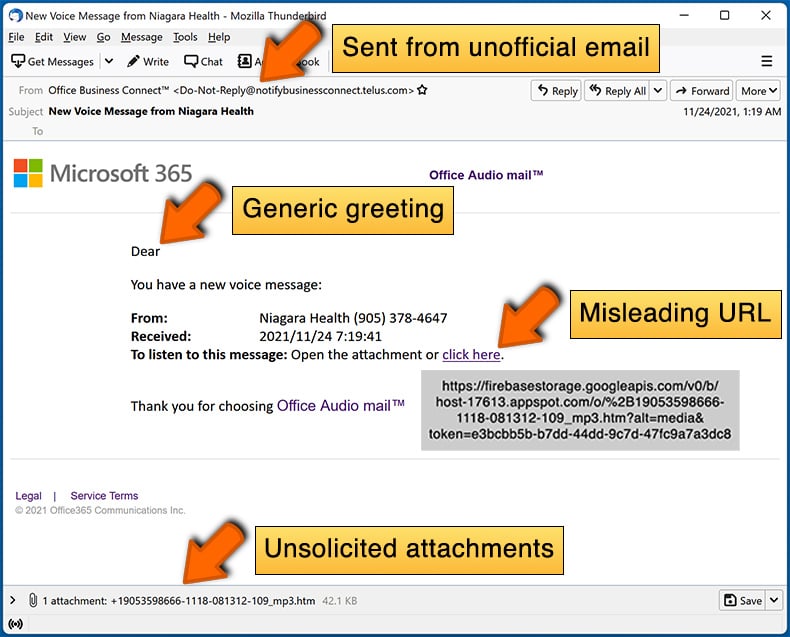How to spot scams like "Donation To Individuals"
Phishing/ScamAlso Known As: Donation To Individuals advance-fee scam
Get free scan and check if your device is infected.
Remove it nowTo use full-featured product, you have to purchase a license for Combo Cleaner. Seven days free trial available. Combo Cleaner is owned and operated by RCS LT, the parent company of PCRisk.com.
What is the "Donation To Individuals" scam email?
Our analysis of the email has shown that it is a deceptive message regarding a donation. Typically, scammers use fraudulent emails like this to extract money and/or trick recipients into disclosing personal information. This and similar messages should not be trusted and should be ignored.

More about the "Donation To Individuals" scam email
The scam email claims to be from Susanne Klatten, a German businesswoman and CEO of BMW (Bayerische Motoren Werke AG). It states that she has donated 25% of her wealth to charity and intends to give away another 25% in 2025, offering a donation of one million euros to 15 individuals.
Recipients are encouraged to contact her via the provided email address (klattensusannehanna@hotmail.com) for more information. Usually, when contacted, scammers try to lure recipients into paying some "administration", "processing", "transfer", or other fees to steal money.
In other cases, the scammers aim to harvest personal details, such as identification information, banking details, or other details, which can be used for identity theft or other types of fraud. Ultimately, no donation is ever delivered.
| Name | Donation To Individuals Email Scam |
| Threat Type | Phishing, Scam, Social Engineering, Fraud |
| Fake Claim | Recipients can receive a large donation |
| Disguise | Letter from Susanne Klatten, CEO of BMW |
| Symptoms | Unauthorized online purchases, changed online account passwords, identity theft, illegal access of the computer. |
| Distribution methods | Deceptive emails, rogue online pop-up ads, search engine poisoning techniques, misspelled domains. |
| Damage | Loss of sensitive private information, monetary loss, identity theft. |
| Malware Removal (Windows) |
To eliminate possible malware infections, scan your computer with legitimate antivirus software. Our security researchers recommend using Combo Cleaner. Download Combo CleanerTo use full-featured product, you have to purchase a license for Combo Cleaner. 7 days free trial available. Combo Cleaner is owned and operated by RCS LT, the parent company of PCRisk.com. |
Similar scam emails in general
Emails like this are often called advance-fee scams. Their purpose is either to steal money through fake fees or to collect sensitive personal information for malicious purposes. Recipients should ignore such messages, avoid responding, and never share any personal or financial details with unknown senders.
Sometimes, emails of this kind can be used to distribute malware. Examples of similar scams are "International Air Transport Association (IATA)", "Internet Crime Complaint Center", and "Fidelity Investments".
How do spam campaigns infect computers?
Threat actors often spread malware via email by attaching malicious files, such as PDFs, Office documents, executable (.exe) files, scripts, or compressed archives like ZIP and RAR. The malware can be activated on their device if the recipient opens these attachments or takes additional steps.
Another frequent method involves embedding links in the email. When clicked, these links may lead to harmful websites that either automatically initiate a malware download or deceive users into downloading it themselves.
How to avoid installation of malware?
Be cautious when dealing with emails, particularly those that include attachments or links. Avoid opening files or clicking on links in unsolicited or suspicious messages from unknown addresses. Regularly update your operating system and applications, and protect your device with trusted antivirus software.
Do not trust pop-ups, advertisements, or fake buttons on untrustworthy websites, and never grant notification permissions to such pages. Download programs and files from legitimate sources, such as official websites or reputable app stores. If you have already opened malicious attachments, we recommend running a scan with Combo Cleaner Antivirus for Windows to automatically eliminate infiltrated malware.
Text presented in the "Donation To Individuals" email letter:
Subject:
Hello I'm Susanne Klatten, a Germany business Woman, investor, and CEO of Bayerische Motoren Werke AG. I gave away 25 percent of my personal wealth to charity. And I also pledged to give away the rest of 25% this year 2025 to Individuals. I have decided to donate 1,000,000.00 Euro to 15 people. If you are interested in my donation, do contact me for more info. email: (klattensusannehanna@hotmail.com) You can also read more about me via the link below: - Warm Regards, CEO Susanne_Klatten. Email: klattensusannehanna@hotmail.com
Instant automatic malware removal:
Manual threat removal might be a lengthy and complicated process that requires advanced IT skills. Combo Cleaner is a professional automatic malware removal tool that is recommended to get rid of malware. Download it by clicking the button below:
DOWNLOAD Combo CleanerBy downloading any software listed on this website you agree to our Privacy Policy and Terms of Use. To use full-featured product, you have to purchase a license for Combo Cleaner. 7 days free trial available. Combo Cleaner is owned and operated by RCS LT, the parent company of PCRisk.com.
Quick menu:
- What is Donation To Individuals advance-fee scam?
- Types of malicious emails.
- How to spot a malicious email?
- What to do if you fell for an email scam?
Types of malicious emails:
![]() Phishing Emails
Phishing Emails
Most commonly, cybercriminals use deceptive emails to trick Internet users into giving away their sensitive private information, for example, login information for various online services, email accounts, or online banking information.
Such attacks are called phishing. In a phishing attack, cybercriminals usually send an email message with some popular service logo (for example, Microsoft, DHL, Amazon, Netflix), create urgency (wrong shipping address, expired password, etc.), and place a link which they hope their potential victims will click on.
After clicking the link presented in such email message, victims are redirected to a fake website that looks identical or extremely similar to the original one. Victims are then asked to enter their password, credit card details, or some other information that gets stolen by cybercriminals.
![]() Emails with Malicious Attachments
Emails with Malicious Attachments
Another popular attack vector is email spam with malicious attachments that infect users' computers with malware. Malicious attachments usually carry trojans that are capable of stealing passwords, banking information, and other sensitive information.
In such attacks, cybercriminals' main goal is to trick their potential victims into opening an infected email attachment. To achieve this goal, email messages usually talk about recently received invoices, faxes, or voice messages.
If a potential victim falls for the lure and opens the attachment, their computers get infected, and cybercriminals can collect a lot of sensitive information.
While it's a more complicated method to steal personal information (spam filters and antivirus programs usually detect such attempts), if successful, cybercriminals can get a much wider array of data and can collect information for a long period of time.
![]() Sextortion Emails
Sextortion Emails
This is a type of phishing. In this case, users receive an email claiming that a cybercriminal could access the webcam of the potential victim and has a video recording of one's masturbation.
To get rid of the video, victims are asked to pay a ransom (usually using Bitcoin or another cryptocurrency). Nevertheless, all of these claims are false - users who receive such emails should ignore and delete them.
How to spot a malicious email?
While cyber criminals try to make their lure emails look trustworthy, here are some things that you should look for when trying to spot a phishing email:
- Check the sender's ("from") email address: Hover your mouse over the "from" address and check if it's legitimate. For example, if you received an email from Microsoft, be sure to check if the email address is @microsoft.com and not something suspicious like @m1crosoft.com, @microsfot.com, @account-security-noreply.com, etc.
- Check for generic greetings: If the greeting in the email is "Dear user", "Dear @youremail.com", "Dear valued customer", this should raise suspiciousness. Most commonly, companies call you by your name. Lack of this information could signal a phishing attempt.
- Check the links in the email: Hover your mouse over the link presented in the email, if the link that appears seems suspicious, don't click it. For example, if you received an email from Microsoft and the link in the email shows that it will go to firebasestorage.googleapis.com/v0... you shouldn't trust it. It's best not to click any links in the emails but to visit the company website that sent you the email in the first place.
- Don't blindly trust email attachments: Most commonly, legitimate companies will ask you to log in to their website and to view any documents there; if you received an email with an attachment, it's a good idea to scan it with an antivirus application. Infected email attachments are a common attack vector used by cybercriminals.
To minimise the risk of opening phishing and malicious emails we recommend using Combo Cleaner Antivirus for Windows.
Example of a spam email:

What to do if you fell for an email scam?
- If you clicked on a link in a phishing email and entered your password - be sure to change your password as soon as possible. Usually, cybercriminals collect stolen credentials and then sell them to other groups that use them for malicious purposes. If you change your password in a timely manner, there's a chance that criminals won't have enough time to do any damage.
- If you entered your credit card information - contact your bank as soon as possible and explain the situation. There's a good chance that you will need to cancel your compromised credit card and get a new one.
- If you see any signs of identity theft - you should immediately contact the Federal Trade Commission. This institution will collect information about your situation and create a personal recovery plan.
- If you opened a malicious attachment - your computer is probably infected, you should scan it with a reputable antivirus application. For this purpose, we recommend using Combo Cleaner Antivirus for Windows.
- Help other Internet users - report phishing emails to Anti-Phishing Working Group, FBI’s Internet Crime Complaint Center, National Fraud Information Center and U.S. Department of Justice.
Frequently Asked Questions (FAQ)
Why did I receive this email?
Scammers typically send identical messages to all recipients. In most cases, the email addresses used are collected from data breaches, fraudulent websites, or other unreliable sources.
I have provided my personal information when tricked by this email, what should I do?
If you have shared any account credentials, change all associated passwords immediately to secure your accounts. If you have disclosed other sensitive information, such as credit card details, identification documents, or banking data, contact the relevant institutions or authorities to report the issue.
I have downloaded and opened a malicious file attached to an email, is my computer infected?
Documents usually cannot infect computers unless users enable macros or perform other steps. However, .exe files can execute malware after being opened. Thus, it depends on the type of file that was opened.
I have sent cryptocurrency to the address presented in such email, can I get my money back?
Such transactions are virtually untraceable, meaning that it is very unlikely that you will be able to retrieve it.
I have read the email but did not open the attachment, is my computer infected?
Simply opening an email is safe. Infection can occur after you click on malicious links or open harmful attachments.
Will Combo Cleaner remove malware infections that were present in email attachment?
Yes, Combo Cleaner can detect and remove nearly all known malware. However, since sophisticated malware often hides deep within the system, performing a full system scan is recommended.
Share:

Tomas Meskauskas
Expert security researcher, professional malware analyst
I am passionate about computer security and technology. I have an experience of over 10 years working in various companies related to computer technical issue solving and Internet security. I have been working as an author and editor for pcrisk.com since 2010. Follow me on Twitter and LinkedIn to stay informed about the latest online security threats.
PCrisk security portal is brought by a company RCS LT.
Joined forces of security researchers help educate computer users about the latest online security threats. More information about the company RCS LT.
Our malware removal guides are free. However, if you want to support us you can send us a donation.
DonatePCrisk security portal is brought by a company RCS LT.
Joined forces of security researchers help educate computer users about the latest online security threats. More information about the company RCS LT.
Our malware removal guides are free. However, if you want to support us you can send us a donation.
Donate
▼ Show Discussion